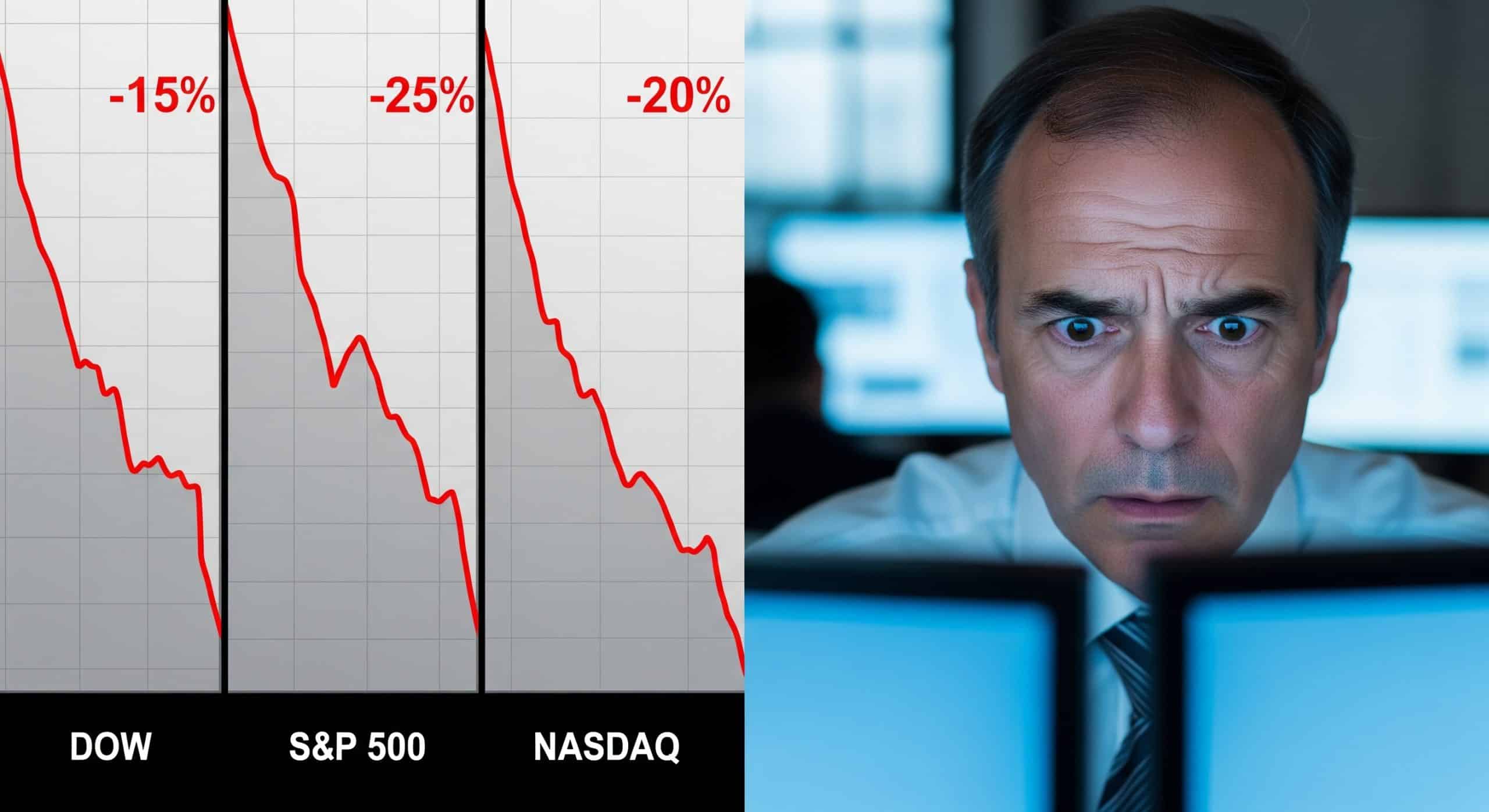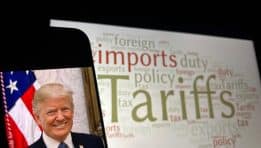The Impact of Trump’s Tariffs on the Stock Market: Analyzing the DOW, S&P 500, and NASDAQ Declines
The recent turmoil in the stock market has sent investors into a frenzy as the DOW, S&P 500, and NASDAQ experienced significant declines. These drops raise questions about market confidence, particularly as Trump’s tariffs play a crucial role in shaping the economic landscape. Let’s delve deeper into how these tariffs and the accompanying weak jobs data have impacted market performance and investor sentiment.
Tariffs, essentially taxes imposed on imported goods, are designed to protect domestic industries. However, when President Trump announced his tariff plans, it sparked anxiety among investors. The belief that tariffs would lead to escalating trade wars raised a red flag for stock traders. As a result, you might have noticed how this uncertainty has fueled fluctuations across major stock indices, including the DOW, S&P 500, and NASDAQ.
Market analysts point to several key factors that have contributed to the recent market downturn. First, let’s take a closer look at the effect of tariffs:
-
Increased Costs: Companies that rely on imported materials faced higher operating costs due to tariffs. Industries such as manufacturing and technology are among the hardest hit, which in turn affects their stock prices.
-
Supply Chain Disruptions: Tariffs disrupt global supply chains, creating delays and inefficiencies. Companies that depend on international trade may struggle to meet production deadlines, harming their bottom line.
-
Consumer Pricing: As companies encounter higher costs, they may be forced to pass those costs onto consumers in the form of higher prices. This leads to hesitance among buyers, impacting sales and, subsequently, stock valuations.
In addition to tariffs, weak job data has further eroded market confidence. Recent reports indicated that job growth is stalling, with fewer new jobs created than expected. This disheartening news raises doubts about the economy’s strength, adding yet another layer of apprehension for investors. With discrepancies in employment figures, you may find that many individuals are questioning the stability of their financial futures.
The connection between job data and stock market performance is critical. Strong job numbers usually correlate with increased consumer spending, which bolsters corporate profits and, ultimately, stock prices. When employment figures lag, as they have recently, it creates a ripple effect:
-
Reduced Consumer Confidence: If people feel uncertain about job security, they are less likely to make purchases. This can lead to decreased revenues for businesses and, consequently, lower stock prices.
-
Investor Sentiment: Investors closely monitor job reports to gauge economic health. Poor job data can trigger a sell-off, as traders react to potential future risks.
-
Policy Implications: Weak job growth may compel the Federal Reserve to adjust interest rates. Such policy changes can directly impact borrowing costs for companies, further influencing their stock performance.
The combination of Trump’s tariffs and disappointing job statistics puts investors on edge. They are worried not only about the present state of the economy but also the future trajectory. The market’s reaction is evident in the substantial drops in the DOW, S&P 500, and NASDAQ, reflecting a lack of confidence that can be hard to recover from.
As we navigate through these uncertain waters, keeping a close eye on economic indicators is more important than ever. The effects of tariffs will not disappear quickly, and job reports will continue to influence market direction. Investors should remain vigilant and informed, as every new piece of data can sway the market’s course.
The current landscape suggests that sustained pressure on the markets may continue unless there are significant shifts in policy or economic indicators. The dialogue surrounding tariffs, trade relations, and employment figures will play an essential role in shaping investor confidence moving forward. Ultimately, understanding these dynamics can equip you with valuable insights into the stock market today and its future direction.
Interpreting Weak Jobs Data: Implications for Investor Confidence and Market Trends
The recent weak jobs data has raised concerns among investors and analysts alike. Slowdowns in job creation can point to a range of economic issues, including decreased consumer spending, lower corporate profits, and a general lack of confidence in market stability. As an investor, understanding the implications of such data is crucial for making informed decisions.
When jobs data shows lower-than-expected growth, several key areas can be affected, thus influencing investor confidence:
-
Consumer Spending: A robust job market typically leads to increased consumer confidence, which drives spending. Weak jobs data can suggest that consumers might cut back on discretionary purchases, potentially harming businesses.
-
Corporate Earnings: Companies often rely on strong consumer spending for revenue growth. If spending falters due to poor job data, forecasts for corporate earnings may also be revised downward.
-
Market Volatility: Investors often react swiftly to economic indicators. Weak jobs reports can lead to increased market volatility as traders adjust positions based on new data.
-
Interest Rates: Central banks closely monitor employment statistics to set monetary policy. Weak jobs data might lead to lower interest rates, which can affect stock market growth and bond prices.
The causes of weak jobs data can vary. Factors such as international trade tensions, geopolitical instability, and shifts in consumer behavior can all contribute. Recent concerns regarding Trump tariffs may weigh heavily on investor sentiment. Tariffs can lead to increased costs for businesses, potentially hampering hiring and investment. As investors, staying informed about these external factors is essential.
Furthermore, the nature of the job data itself can influence market interpretation. For instance, if the unemployment rate remains steady but job growth is sluggish, this might suggest that people are dropping out of the labor force, rather than a lack of opportunities. Such nuances can alter how investors perceive market conditions.
Notably, sectors like technology and consumer discretionary might be more sensitive to weak job data. Investors in these areas should pay close attention to emerging trends and adjust their strategies accordingly. For example, a slow job market may lead to decreased sales in luxury goods, which could adversely affect companies in that sector.
It’s also essential to recognize that weak jobs data can sometimes influence investor behavior beyond stock price moves. Here are a few potential behaviors investors might exhibit:
-
Flight to Safety: Investors often gravitate toward safer investments, such as government bonds or other low-risk assets, during periods of uncertainty. A downturn in jobs data might prompt a shift away from equities.
-
Rebalancing Portfolios: Investors may reconsider their asset allocations, pulling funds from higher-risk investments and reallocating to more stable sectors.
-
Increased Research and Analysis: In response to weak data, investors may become more diligent in analyzing market conditions, search for emerging trends, and seek opportunities that may appear in less affected sectors.
Market reactions to weak jobs data are often immediate and can linger. Prices may slump initially, yet markets can correct as additional information becomes available. Investors should remain vigilant and gather a comprehensive understanding of both current conditions and potential implications.
In times of economic uncertainty, communication is vital. Companies should be transparent about hiring practices and earnings forecasts. Clear messaging can help mitigate investor fears, providing a more stable investment environment. Similarly, analysts play a crucial role in interpreting data and guiding investors through turbulent times.
Ultimately, weak jobs data is just one piece of a larger economic puzzle. It reminds investors to look beyond short-term fluctuations and focus on broader trends. Understanding the motivations and circumstances behind labor market changes can help you navigate the market more effectively.
As headlines continue to highlight weak jobs data and its links to investor confidence, staying informed and adaptable is key. Aligning your investment strategy to account for these economic signals can make a significant difference in your financial health in the long run. Remember, a proactive approach often leads to better decision-making, especially when the market is volatile.
Conclusion
As we reflect on the day’s trading, it’s clear that both the implications of President Trump’s tariffs and the recent weak jobs data have significantly shaken market confidence. The DOW, S&P 500, and NASDAQ are reacting sharply, showcasing investors’ anxiety over potential trade wars and their broader economic impact. Increased tariffs can lead to higher consumer prices, reduced spending, and ultimately, a slowdown in economic growth. Consequently, the fear of slowing profits is pushing investors to retreat, leading to a sell-off in these major indices.
Moreover, the disappointing job numbers paint a cautious picture for the economy. When job growth falters, investor sentiment tends to dwindle, amplifying fears of recession. With fewer people working and earning a steady income, consumer spending—the backbone of the U.S. economy—may suffer. The combination of these factors has created an environment where caution is becoming the norm among investors and traders alike.
Looking ahead, stakeholders must navigate this new landscape with care. Understanding the interconnectedness of tariffs, job performance, and their impact on market dynamics is essential. Investors should closely monitor upcoming economic indicators as well as government policy changes to make informed decisions. The road may be bumpy, but staying informed and agile can help you better weather these turbulent market conditions.
Comparison, examination, and analysis between investment houses
Leave your details, and an expert from our team will get back to you as soon as possible
* This article, in whole or in part, does not contain any promise of investment returns, nor does it constitute professional advice to make investments in any particular field.
To read more about the full disclaimer, click here- Articles
- •
- 18 Min Read
- •
- ago 4 minutes
 COINBASE SHOWS HUGE UNUSUAL OPTIONS VOLUME AFTER LOWER RESULTS
COINBASE SHOWS HUGE UNUSUAL OPTIONS VOLUME AFTER LOWER RESULTS
Analyzing the Impact of Unusual Options Volume on Coinbase After Lower Financial Results After a recent announcement of lower financial
- ago 4 minutes
- •
- 18 Min Read
Analyzing the Impact of Unusual Options Volume on Coinbase After Lower Financial Results After a recent announcement of lower financial
- Arik Arkadi Sluzki
- •
- 14 Min Read
- •
- ago 20 minutes
 The TACO trade won’t save the market from Trump’s latest tariff blitz
The TACO trade won’t save the market from Trump’s latest tariff blitz
Analyzing the Impact of Trump's Latest Tariff Blitz on the TACO Trade The recent implementation of additional tariffs by the
- ago 20 minutes
- •
- 14 Min Read
Analyzing the Impact of Trump's Latest Tariff Blitz on the TACO Trade The recent implementation of additional tariffs by the
- Arik Arkadi Sluzki
- •
- 12 Min Read
- •
- ago 51 minutes
 Meta to share AI infrastructure costs via $2 billion asset sale
Meta to share AI infrastructure costs via $2 billion asset sale
Impact of Meta's $2 Billion Asset Sale on AI Infrastructure Costs Meta's recent decision to sell off $2 billion worth
- ago 51 minutes
- •
- 12 Min Read
Impact of Meta's $2 Billion Asset Sale on AI Infrastructure Costs Meta's recent decision to sell off $2 billion worth
- Articles
- •
- 18 Min Read
- •
- ago 57 minutes
 US DEFENSE BILL PROPOSES EXAMINATION OF APPLE DISPLAY SUPPLIER
US DEFENSE BILL PROPOSES EXAMINATION OF APPLE DISPLAY SUPPLIER
The Implications of the US Defense Bill's Proposal for Examining Apple's Display Supplier The recent proposal in the US Defense
- ago 57 minutes
- •
- 18 Min Read
The Implications of the US Defense Bill's Proposal for Examining Apple's Display Supplier The recent proposal in the US Defense












